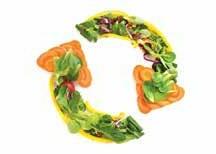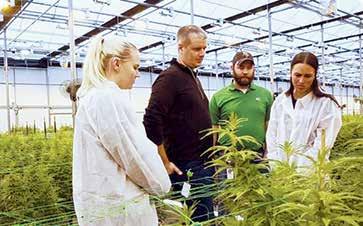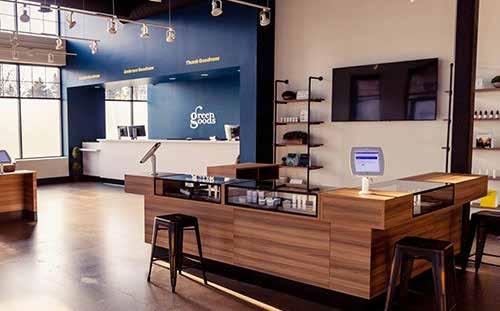
14 minute read
plant medicine
june
men’s health
Advertisement
july
food connection

august
self-empowerment
learn about marketing opportunities at: 724-271-8877
plant medicine
Partake in the Wisdom of Solomon
by April Smith
Solomon’s Seal (Polygonatum), is a sweet, nutritious wild edible. It grows in clumps of stems ranging to three feet in deciduous woodlands through the east coast. The origin of the name of this plant is shrouded in folklore, stemming from the unique markings of the rootstalk that resemble Hebrew characters and flower shape. The flower’s petals resemble a star. The young sprouts are a source of trail food. It is known to reduce premenstrual syndrome symptoms and enhance fertility for women. Males used it to enhance low libido naturally. Add comfrey into a salve or oil to promote wound healing and minor skin irritations such as poison ivy. Used topically on the skin, it promotes a healthy, clear, radiant complexion.

Simply Solomon Oil Preparation
Method 1: Wash and cut/chop the rhizomes and put them in a small saucepan. Cover with olive oil (recommended) and let simmer over low heat for approximately 25 minutes. Remove from heat. Cover and let cool. Strain with a cheesecloth and keep in a cool dark area (up to a year). Method 2: Place dried rhizomes in a mason jar with a choice of oil. Seal. Let set in a window seal for two to six weeks. Strain the liquid with a cheesecloth. Place remaining oil in an airtight container of choice. Store in a cool/dark area (this method will last longer but will be less potent).
Special Precautions
Pregnancy and breastfeeding: There is insufficient research about using Solomon’s Seal during pregnancy and breastfeeding. Stay on the safe side and avoid use. Diabetes: Solomon’s Seal might decrease blood sugar levels. There is some concern that it might interfere with blood sugar control. If using Solomon’s Seal and taking diabetes medications, monitor blood sugar closely.
Solomon’s Seal is an endangered species; harvest ethically and replenish the local environment. If this species grows abundantly on private property, harvest in small quantities. Solomon’s Seal is an easily cultivated plant, so add a row into this year’s gardening plans.
April Smith is the owner of Native Holistics. For more information, call 1-304-999-4372 or visit NativeHolistics.com. See ad, page 19.

Tour of grow facility Plants as Medicine
A Vision for the Future of Health Care
by Sven Hosford
Medical doctors gathered recently in Minneapolis to discuss the use of plants – particularly cannabis—in their practice. One presenter talked about a system of “plantbased synergistic polypharmacy supporting homeostasis... Not pitted against, but supporting the next breakthrough reductionist intervention with remarkable short-term power and efficacy.” In other words, a future where pharma-oriented medicine and plantoriented medicine work in harmony.
So believes Dr. Stephen Dahmer, chief medical officer of Vireo Health and its parent company Goodness Growth Holdings, Inc. In early April, they hosted the Spring into Cannabis Symposium, a two-day event that included continuing medical education credits (CME) to qualifying medical professionals—a rare opportunity at cannabis educational events—and a tour of one of their growing operations. Goodness Dr. Stephen Dahmer Growth is a physician-led, science-focused cannabis company and intellectual property developer, and its subsidiaries Vireo Health and Green Goods make it one of the largest multi-state operators growing, selling and researching medical cannabis in the country.
While Dahmer’s vision of a future plant-oriented medical system involves far more than just cannabis, the revolution that cannabis is bringing to the system is helping to change the minds’ of medical doctors, creating a new way of thinking about health care. He discussed the symposium and his vision in a recent podcast interview. For him and his colleagues, it all starts with solid science. “Minnesota has a fantastic medically oriented program,” he says. “The department of health there does fantastic research in asking questions directly to patients and providers. They maintain a registry—one of few in the world—that are monitoring those patients in the program and routinely publishes results from that.”
Dahmer hears a general call among providers for more CME. He said, “Physicians—especially of my age—received zero education about the endocannabinoid system in medical school. The only thing we learned about cannabis was the derogatory and negative effects. So we know nothing about harnessing potential benefits or how to best consult and work with patients that are interested in exploring this path.”
This gap is what the symposium was designed to help fill. “There is so little we do know about the positive potential for this plant, we need to build off one another,” he said. “This is not coming through the usual pipeline. We need to create this content ourselves.”
The first day’s speakers were very well received, says Dahmer, but the highlight for many was a tour of Goodness Growth’s grow facility on the second day. “So many providers for the first time got to actually see where these plants are grown and the process by which our medicines are made. For every provider I bring through, it’s a remarkable experience to see the actual plants that we offer to our patients.”
Dahmer sees that physicians are more eager to learn more about the endocannabinoid system. He says, “It’s an endogenous system that is super-modulatory toward homeostasis. I can’t think of one that could be more pertinent and important right now. As a primary care doctor, 80 to 90 percent of what I see is related to stress. So something that oversees resilience and our body’s ability to deal with stress... what an amazing system that we are just scratching the surface of. Every day, exponential, we are learning more.”
“We are ready for a paradigm shift,” Dahmer says. “We’re seeing mostly chronic disease, where something with a softer impact on our physiology would be more useful. I’m just enthralled with the idea of the entourage effect—this polypharmacy that occurs within the plant. I think this is going to form a solid part of the future of medicine.
“I don’t want to come off as anti-pharmaceutical or anti-Western medicine. There are so many things for which it’s remarkably effective; specifically, acute care medicine. There’s nothing I know that is more effective—as opposed to chronic care medicine, which is more complex and needs a more complex approach in how we treat it. So many aspects of medicine are starting to go in this complexity direction because we know that’s what is going to be needed to tackle these situations.”
To view the symposium and earn CME credits, visit GoodnessGrowth.com or VireoHealth.com. To listen to the entire conversation, visit NaturalAwakeningsswpa.com.


Resilient Mothering
How Moms Are Forging Ahead in a Changing World
by Carrie Jackson
Two years after “coronavirus” became a household word, the pandemic continues to affect every aspect of our lives. Mothers, in particular, have learned to reimagine what it means to be a parent, employee, partner and friend, while still finding time for themselves. According to the Kaiser Family Foundation, almost 70 percent of mothers say that worry and stress from the pandemic have damaged their mental health.
While social distancing, quarantining, remote learning and masking quickly became a new and often unwelcome normal, positive shifts have also been developing. Already resilient mothers are exploring how to adapt to an ever-changing situation and learning when to hold on and when to let go. They are discovering new ways to be available for their children’s mental health, maintain their jobs, stay connected with other moms and prioritize self-care.
Shae Marcus, publisher of Natural Awakenings South Jersey (NASouthJersey.com), says that the pandemic has brought a number of unforeseen silver linings. As a single mother of two young children, she has been in a constant state of transition the last two years and is starting to achieve greater balance. “Like most other mothers, my life before the pandemic was nonstop. I was getting by, and at the same time comparing myself to other parents. The world had to slow down so I could catch up, and I’ve been forced to stop, breathe and take it in stride,” she says.
Marcus shares a common concern, that the isolation has affected her kids’ development. “I worry that the lack of social integration over the past two years will have a lasting impact on my children. My son, who is now in third grade, was in kindergarten the last time he had a full year in a ‘normal’ school setting. That’s a lot to miss out on. While he is academically on track, I’m concerned about him being mature enough. Having sports and other extracurricular activities starting back now is helping to get them integrated again, and I’m able to fully appreciate going to an outdoor spring football game that wasn’t able to happen for so long,” she says.
Marcus has discovered that working from home has had advantages. “Now, I can do a load of laundry in-between meetings, go to the grocery store when I would have been commuting and be more present when my kids are home. Since I’m not worried about rushing out the door, we have time to talk during breakfast, and I’m able to accompany them to the bus stop. Afterwards, I take 10 minutes for myself to walk around the block and gather my thoughts for the day,” she explains.
Reordering Priorities
Seventy-one percent of mothers describe being a working mom during the pandemic as very challenging, according to research done by the global consultancy group APCO Impact. As president of Families and Work Institute (FamiliesAndWork.org), a New York-based research nonprofit, Ellen Galinsky has seen employers grant access to a wider variety of benefits that fit their employees’ individual and family needs. “The pandemic, coupled with racial reckoning, has made many of us rethink our priorities. It now is becoming clear that the world that seemed relatively normal before wasn’t working. Mothers and fathers were thrust on the front lines of schooling and saw firsthand how different teaching and parenting are,” Galinsky notes.
An estimated 82 percent of employers plan to allow their employees to keep working remotely after the pandemic, reports a survey by human resources consultancy Mercer, but that turnaround is just a first step, says Galinsky. “Studies show that having workplace flexibility procedures in place is a floor, but how employers treat you when you need that flexibility matters the most. The pandemic made us all experience collective and multiple losses together and brought some difficult issues to light,” she explains.
In juggling work and life duties, Galinsky shies away from the word “balance”, which suggests that time and energy needs to be split evenly. “Work and home lives are deeply intermingled, and often when one is in sync, the other will follow,” she says. “It’s important for mothers to set realistic expectations for themselves and let go of the notion that they’re not doing a good job, their kids have to be perfect or they don’t have time to take care of themselves. Children will absorb what they see, so being mindful in your words and actions around work will have an impact on them. If you have a stressful meeting and bring that home with you, the energy in the house will change. It’s okay to tell the kids that you’re upset at your boss and are going to call a friend and talk or go for a walk; let them know it’s not their fault and that parents get stressed, too.”
Stress Survival Skills
The pandemic also put many mothers in a chronic state of hypervigilance, because they not only had to manage their own anxiety, but also help kids manage their experiences. A University of Rochester study of 153 mothers of toddlers found that ongoing strains can disrupt the body’s natural stress response, making it more difficult to respond with patience and sensitivity to a child’s needs.
Elizabeth Cohen, a clinical psychologist and director of the Center for CBT (cognitive behavioral therapy) in New York City (CenterForCBTInNYC.com), says that a shock to the nervous system can only be released with the acknowledgement that the trauma is being experienced in the first place. “Having an understanding of how you’re responding to this stress and uncertainty is key to moving through it. Even going back to the office after so long may trigger a panic attack if the trauma of the past two years isn’t addressed,” she says. “Mothers need to practice compassionate awareness for themselves and what they’ve gone through. They need to be seen, heard and witnessed in the same way their children are.”
SELF-CARE FOR STRESSED-OUT MOMS
For mothers trying to juggle it all, making their own mental health a priority is key. Here are some practical ways busy moms can incorporate their overall wellness into a daily routine.
Set Up Self-Care: Sneaking in breaks throughout the day can have a positive cumulative effect. Follow a guided meditation while waiting for soccer practice, use essential oils in the car, keep a favorite lotion next to the bed or savor a favorite nourishing snack.
Cultivate a Network: Nurturing relationships with supportive peers can provide emotional and social support. Meet a friend for a morning coffee or afternoon walk, join a book club, host a potluck with other mothers or volunteer with a community group.
Prioritize Therapy: The right therapist can provide an unbiased and supportive perspective and help process new and lingering issues. Find a practitioner that understands a mom’s unique needs and a modality that resonates with us. Traditional talk therapy works well for some, but be open to exploring other forms, such as movement therapy or art therapy.
Keep Communication Open: Modeling and encouraging dialogue gives kids a safe space to practice sharing and lets everyone feel valued. Find time during car rides, at the dinner table or before bed to check in with the family and share each other’s thoughts.
Take a Class: Learning a new skill can spark creativity and help build a social network. Try a pottery workshop, join a dance club, take a photography class or study a foreign language just for fun.
Cohen advises that while part of a mother’s job is to make kids feel emotionally safe, it’s not as effective if they are themselves depleted. She recommends adopting simple, actionable practices throughout the day to help restore and reset the mind and body, suggesting, “Put some Epsom salt in the bottom of the tub and allow your feet to soak for a few minutes during a shower. Before brushing your teeth, take three deep breaths and pay attention to where you might be feeling tension in your body. Keep a gratitude journal handy to reflect and record your observations and interactions.”
She advises us to remember that we have all had different experiences of this trauma, and nobody is the same as they were in 2019. “It’s okay to tell a friend, ‘I’m excited to see you and also, I’m uncomfortable not wearing a mask.’ We’ve also had to be more selective about who we spend time with, and that has allowed us to foster more nurturing relationships,” she says. “Be more discerning about who you spend time with, instead of saying yes to every invitation to get coffee. It’s okay to do less, and making authentic decisions in the moment will help you truly feel aligned with your thoughts and actions.”
Joint Healing
Claire Zulkey, a Chicago-based writer and mother of two young boys, has found creative ways to stay connected with other mothers and not feel so isolated. She pens a newsletter, Evil Witches (EvilWitches. substack.com), which gives her a platform to share stories of everyday motherhood triumphs and concerns. Topics have included perimenopause, end-of-life options for the family pet, finding the best hand lotion and other subjects that mothers in her circle think about.
She also maintains a Facebook group of 100-plus mothers, providing a safe place for members to commiserate and support each other. “The group has allowed me to really get to know mothers in a more intimate way, truly understand what they’re going through and appreciate how much they care about their kids,” says Zulkey.
She made a personal decision to stop drinking a few months into the pandemic, a lifestyle choice that she has maintained for the past year. “While I was not an alcoholic, there were too many times when I would wake up with a hangover or get into a tipsy argument with my husband. I quickly learned to appreciate how much easier parenting is when I’m in a stable mood, and the entire household has benefited, especially during the pandemic, when we were in such close quarters,” she says.
For all of us, moving forward after two years of collective grief, loss and uncertainty will undoubtedly present new unforeseen challenges, yet maintaining a sense of perspective can help if things start to feel overwhelming. “At the start of the pandemic, I started to feel sorry for myself, but soon I realized that I actually was so much better off than a lot of people. Once I oriented myself with that reality, it was easier for me to move on with a sense of gratitude and desire to help others,” says Zulkey.
Carrie Jackson is an Evanston, IL-based freelance writer and frequent contributor to Natural Awakenings magazine. Connect at CarrieJacksonWrites.com.








